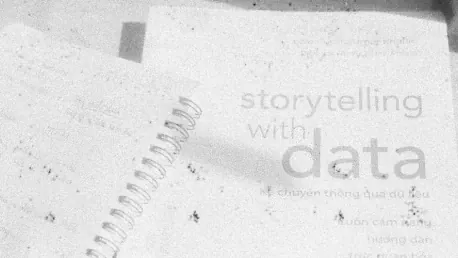When people discuss “data analysis,” they often reference applications involving spreadsheets, algorithms, and math, which represent the necessary skills. However, the practical analysis also encompasses strong communication abilities. Merely reporting numbers is insufficient; brands must tell a story about their products.
According to the Bureau of Labor Statistics, employment of research analysts will likely expand by 25% in 2020/2030, which is more than the average level of all occupations. Many businesses nowadays have hired data storytelling specialists as additional members of analytics organizations. If you are blessed with Occam’s razor and the talent to tell a good story, your probability of getting a fantastic gig or a raise is much higher.
This article will explain the intricate facets of data storytelling, the power behind its communication effects, and how to construct such a story.
What is Analytical Storytelling?
It refers to conveying simple stories and graphics based on analytical datasets. This approach backs data with real-life examples to engage the audience and inspire action.
There are three essential components of compelling analytical plotting:
Data: Your plot lines stem from sound analysis of accurate information. Utilizing descriptive, diagnostic, predictive, and prescriptive views provides a comprehensive understanding of the data.
Narrative: This is the oral or written account that combines insights from the data with a plotline, directing the actions you want your audience to take.
Visualizations: Charts, graphs, diagrams, images, and videos communicate the data’s story clearly and memorably.
Thus, analytical fiction can affect how you approach internal improvements based on user feedback or to persuade potential customers to purchase a product. It transforms data into engaging anecdotes that influence audiences by presenting several key benefits.
Benefits of Evidence-Based Narratives
Evidence-based stories share similarities with traditional storytelling but offer unique advantages through graphical data visualizations, such as graphs and charts. This approach simplifies complex information, allowing the audience to make informed decisions confidently.
Key benefits include:
Adding Value: Contextualizing data enhances insights and increases their impact.
Simplifying Complexity: Distilling intricate information into essential points makes it accessible to a broader audience.
Humanizing Data: A narrative adds a personal touch, helping audiences connect with the content.
Establishing Credibility: Effectively communicating data-driven insights positions you as a thought leader in your field.
The Psychological Power of Storytelling
Humans have communicated through stories since the Cro-Magnon era, using them to survive and document daily life. While narrative creation techniques have evolved since the days of cave paintings, their psychological impact remains significant thousands of years later.
The brain prefers stories to raw data because it processes vast amounts of information daily, distinguishing what is essential to retain and what it can ignore.
When you create and share fictional details, the brain employs several areas, including:
Wernicke’s area, responsible for language comprehension;
The amygdala, which processes emotional responses;
Mirror neurons store empathy and the capacity to connect with other people.
Whatever you do to activate many areas of the brain makes it more likely that the hippocampus—the area of the brain in charge of short–term memory—will convert the experience of listening to a commercial into a following a story that the listener will remember.
Instead of providing your team with numbers written on a spreadsheet, you have to think about how to challenge them more. This method enables one to call for an emotional response to enhance the insight gained from the experience.
How to Craft a Compelling and Valuable Narrative
Creating a compelling story requires a structured approach that integrates all relevant data to confirm your hypotheses and identify desired changes:
Review All Data: Avoid selective analysis that only supports your theory; aim for a balanced view to ensure credibility.
Define Your Theory: Clearly articulate what you want to prove or disprove. This forms the foundation of your creative content.
Collect Relevant Data: Gather the datasets necessary to support your creation.
Clarify the Purpose: Summarize your story’s goal in a single sentence to guide your plot.
Outline Your Narrative: Plan the structure of your story from introduction to conclusion, incorporating essential elements like characters, setting, conflict, and resolution.
Reflect on Your Hypothesis: Assess whether your initial assumptions were correct and how they influenced your product/service descriptions.
Set Audience Goals: Determine the actions you want your audience to take after engaging with your story.
The Three Key Elements of Effective Data Plots
Telling a story with data integrates three essential components, text, visuals, and data, to effectively convey your insights.
Build Compelling Product Fiction: Always include data in the form of facts and figures to support the conclusions you draw from your analysis. Make complex knowledge accessible so that people can visualize it.
Use Visuals to Enlighten: Correlate visual materials, such as charts and graphs, with the plot to reveal connections. Provide ample data to deepen understanding.
Show Data to Support: Include business analytics tools to enhance your narrative’s clarity.
Suppose you are a data analyst and notice a problem, such as a decline in purchases from customers aged 14 to 23 due to a viral social media post highlighting your company’s negative environmental impact.
Here’s how to organize your story:
Characters: Identify your stakeholders: the affected customers, eco-conscious consumers, and your organization’s employees.
Setting: Discuss the situation of declining sales, supported by visualizations that illustrate this trend, particularly among users under 25.
Conflict: Describe the central conflict: growing awareness of your company’s operations. Use research to show the consumer trend toward sustainability and back this with visualizations.
Resolution: Propose your courses of action, such as shifting to sustainable practices. Emphasize the need for marketing strategies to highlight this change and attract environmentally conscious consumers.
A data narrative can stir emotions, influence decisions, and inspire action with the right approach.
Using Data Visualization
Incorporating information visualization is crucial. By transforming large datasets into easily understandable visuals, you can help your audience grasp the information accurately.
Effective visualizations can:
Reveal patterns and insights
Provide context and explain outcomes
Simplify complex information for better processing
Enhance audience engagement
Examples of Analytical Storytelling
Narratives, such as dashboards, infographics, and visualizations, can take various forms. Here are some practical examples:
Dashboards: Deliver sufficient information to shape the story and maintain continuity.
Visualizations: A call center analysis can combine various visualizations to assess customer satisfaction.
Infographics: Serve as creative summaries of datasets, highlighting key findings.
Benefits of Data Dashboards
Utilizing data dashboards can significantly aid in presenting your visuals:
Improved Visibility: Gain insights into past and present trends.
Accurate Forecasting: Make more precise predictions of future trends.
Performance Tracking: Examine metrics from multiple sources that indicate organizational performance.
Real-Time Analytics: Access immediate insights into customer behavior.
You can construct a compelling analytical narrative that educates and motivates change using these elements and techniques.
The Impact of Analytical Storytelling on Information Consumption
The information on building lore around analytical data presented here shows how compelling stories can revolutionize information sharing and analytical findings. They transform pure numbers into more relatable insights, making it easier to comprehend complex data. A persuasive story goes beyond merely providing information; it also fosters awareness, engagement, and action.









